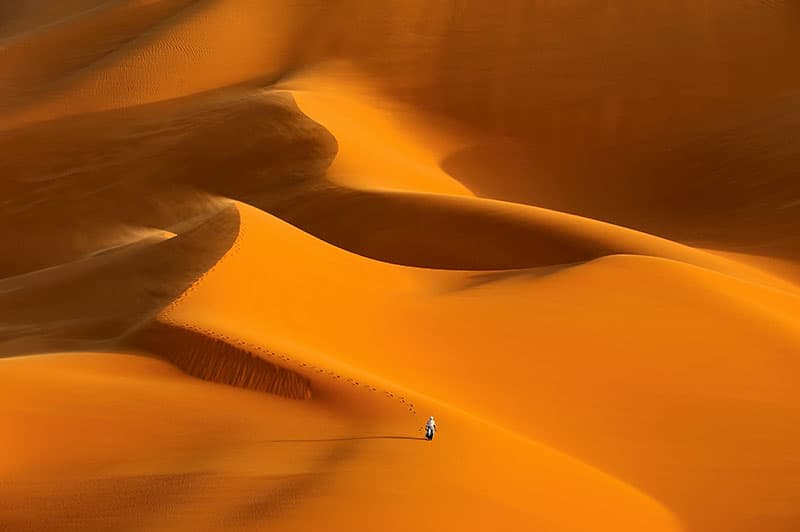Photo Insight Bringing You Essential Expert Advice Every Week
Marsel van Oosten’s – Sahara Desert

Marsel van Oosten is a professional nature photographer from the Netherlands. Together with his wife Daniella, he runs specialised nature photography tours and workshops for small groups of all experience levels to spectacular locations worldwide.
Marsel van Oosten’s series ‘Dwarfed’ was recently lauded at the International Photography Awards. He talks us through this shot from the series.
This shot was taken in south-west Libya, in the Sahara Desert. I’m standing at the lowest part of that area of the desert, on the flat, next to my four-wheel-drive vehicle. I am quite a long distance away from the dunes in the picture, so you can tell they’re incredibly high.
The little guy you see in the picture is actually walking towards me. I shot him walking in the dunes, walking down the dunes and walking straight towards me with all kinds of different focal lengths. This particular shot was at a focal length of near 200mm on my Nikon 70-200mm f/2.8 VR lens, on a Nikon D3S.
This image is part of a series of five called ‘Dwarfed’. The idea of the series is that they all feature very big landscapes with very small people to give a sense of scale, and to add drama. That’s something I really like to do, to create impressive landscape images with something extra. In this case, it’s the addition of a person.
Most of the photographers I know and who I see on my tours seem to dislike including people in their images, and they go to great lengths to keep them out. Sometimes I can understand why they do that, but often in a landscape that features something really high, deep or wide, it’s almost impossible for the viewer to gauge how big it truly is. Adding a person for scale benefits our understanding of the landscape.
Most of the images in ‘Dwarfed’ feature landscapes that are very big, but not very well known, so I think it makes sense to do it this way by adding a human figure. I also think that adding a small human element adds a lot of drama to the landscape. These figures are usually only maybe 10 pixels high or so, but if you take those 10 pixels out then that whole image is just not so impressive.

The biggest problem with shooting in the desert isn’t the heat, as you can dress for this and take precautions. What’s more of an issue is the dust and the sand. When I took this shot, my wife and I were spending several months in the Sahara in different countries in Northern Africa. At the time, I only had two camera bodies and three lenses with me, so that meant sometimes I had to changes lenses. That was a nightmare. It was just impossible because there was always wind, and no way really to hide from it, even in the car, because it was just so dusty. I ended up with one sensor that was so dusty I couldn’t use it any more.
So, from then on, I decided that when I travelled next to the Sahara I wouldn’t change lenses. Now I take three camera bodies, three lenses and leave each lens on one camera at all times. On one body I have a 14-42mm wideangle zoom, on the second I have a 24-70mm and the third body has the 70-200mm with which I shot this image. This means I’m covered from 14mm to 200mm, which is more than enough in these sorts of conditions.
This entire shot is planned. The person you see walking in the image is our guide, with whom we travelled for a couple of weeks. I had spotted this scene a couple of days before and decided to wait for the right circumstances – better light and more wind. When the conditions were good, we returned to this place.
I took a photograph of the scene and showed it to my guide, using it to instruct him how to walk. I told him to walk through the dunes, first up, then to the left and then down again, allowing me to take a whole series of photographs with the fewest footsteps possible. He walked up outside of the frame to the right, behind those ridges, and then he emerged from the shadowed area and walked down that main ridge.
As already mentioned, this is one shot of many. I didn’t like the shots I took a little earlier as our guide was on one of those diagonal ridges and the composition didn’t work. The later shots didn’t work for me, either, because by then I had to point the camera down too much and I had lost that compressed perspective. This was just the right shot for the right focal length.
Marsel van Oosten was talking to Jon Stapley
To see more of Marsel’s images, visit his website at www.squiver.com








